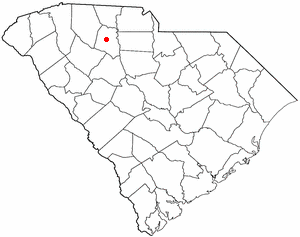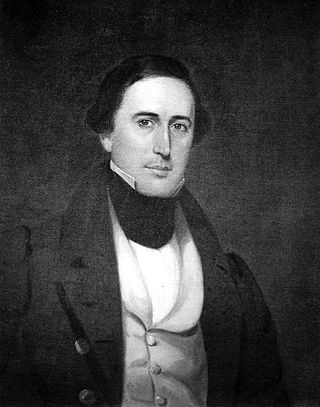
The city of Union is the county seat of Union County, South Carolina, United States. The population was 8,393 at the 2010 census. It is the principal city of the Union Micropolitan Statistical Area, which includes all of Union County and which is further included in the greater Greenville-Spartanburg-Anderson, South Carolina Combined Statistical Area.

The Charles Pinckney National Historic Site is a unit of the United States National Park Service, preserving a portion of Charles Pinckney's Snee Farm plantation and country retreat. The site is located at 1254 Long Point Road, Mount Pleasant, South Carolina. Pinckney (1757-1824) was a member of a prominent political family in South Carolina. He fought in the American Revolutionary War, was held for a period as prisoner in the North, and returned to the state in 1783. Pinckney, a Founding Father of the United States, served as a delegate to the constitutional convention where he contributed to drafting the United States Constitution.

William Henry Gist was the 68th Governor of South Carolina from 1858 to 1860 and a leader of the secession movement in South Carolina. He was one of the signers of the Ordinance of Secession on December 20, 1860, which effectively launched the Confederate States of America.

The Nathaniel Russell House is an architecturally distinguished, early 19th-century house at 51 Meeting Street in Charleston, South Carolina, United States. Built in 1808 by wealthy merchant and slave trader Nathaniel Russell, it is recognized as one of the United States' most important neoclassical houses. It was designated a National Historic Landmark in 1973.

The Fireproof Building, also known as the County Records Building, is located at 100 Meeting Street, at the northwest corner of Washington Square, in Charleston, South Carolina. Completed in 1827, it was the most fire-resistant building in America at the time, and is believed to be the oldest fire-resistant building in America today.

Hampton Plantation, also known as Hampton Plantation House and Hampton Plantation State Historic Site, is a historic plantation, now a state historic site, north of McClellanville, South Carolina. The plantation was established in 1735, and its main house exhibits one of the earliest known examples in the United States of a temple front in domestic architecture. It is also one of the state's finest examples of a wood frame Georgian plantation house. It was declared a National Historic Landmark in 1970.

Rose Hill Plantation State Historic Site is a historic site in Union County, South Carolina, that preserves the home of William H. Gist (1807–1874), the 68th governor of South Carolina. Gist helped instigate a Secession Convention in South Carolina, which led to the creation of the Ordinance of Secession that preceded the Civil War.

This is a list of the National Register of Historic Places listings in Newberry County, South Carolina.

This is a list of the National Register of Historic Places listings in Marion County, South Carolina.

Stone House by the Stone House Brook, also known as Old Stone House, is located at 219 South Orange Avenue in South Orange, Essex County, New Jersey, United States. It is one of the oldest extant structures in New Jersey, the original portion house built prior to 1680. The building was added to the National Register of Historic Places on November 22, 1991, for its significance in historic archaeology, education, community planning and development, and politics/government.

The Means House near Jonesville, South Carolina was built in 1821. Situated on an isolated 20 acres in rural Union County SC, the 2650 square foot Means House has been listed on the National Register of Historic Places since 1973. The listing, in 1973, included two contributing buildings on 20 acres (8.1 ha).

Union Church of Port Royal, also known as Port Royal White Union Church, 11th Street Tabernacle, and Free Church of Port Royal, is a historic church located at Port Royal, Beaufort County, South Carolina. It was completed in 1878, and consists of a one-story, wood frame, brick-piered building with a central entry and portico. It has a cupola containing the church's belfry. It was built with donated lumber by local citizens in 1877–1878 to provide the Port Royal community its only white house of worship at that time.
Richmond Plantation, also known as Girl Scout Plantation, is a national historic district located near Cordesville, Berkeley County, South Carolina. It was built about 1927, and includes a manor house and outbuildings constructed as a hunting lodge for George A. Ellis, a prominent New York financier and co-founder of E. F. Hutton & Co.

Seaside Plantation House, also known as Locksley Hall, is a historic plantation house located at Edisto Island, Colleton County, South Carolina. It was built about 1810, and is a 2+1⁄2-story, Federal style brick dwelling with a gable roof. The house is one room deep with a long porch across the southeast elevation and sits on a raised basement. The central portion of the house is stuccoed brick with frame additions on the first floor.

Cool Springs is a historic home located near Camden, Kershaw County, South Carolina. It was built about 1832, and is a two-story Greek Revival style house on a raised brick basement. The original house was remodeled in the 1850s. It features a tiered portico and verandahs, supported by 64 Doric order columns. A two-story kitchen addition was attached to the house about 1935. Also on the property are the contributing two horse stables, a concrete piscatory, an old stone spring, a brick basin, a dam, and granite gate posts.

Union Station, also known as Atlantic Coast Line Railroad and Southern Railway Station, is a historic train station located at Columbia, South Carolina. It was built in 1902, and is a brick and stone, eclectic Jacobethan Revival / Tudor Revival building. It features stepped gables and towering chimneys. It was designed by architect Frank Pierce Milburn for the Atlantic Coast Line Railroad and Southern Railway. In contrast to the custom of 'union station' denoting the single station for several railroads, the Seaboard Air Line Railroad had its own station one-half mile away. The formerly Seaboard Silver Star still operates through another station in Columbia.

Cross Keys House is a historic plantation house located at Cross Keys, Union County, South Carolina. It was built about 1812–1814, and is a two-story, five-bay, brick Georgian Colonial style dwelling. It features a gabled roof with identical pairs of end chimneys, a massive raised first-story portico, and date stones carved with the date of the house's completion (1814), original owner's initials (B.B.), and crossed keys thought to be the insignia of the builder.
New Market, also known as the McDonald-Rhodus-Lesesne House, is a historic home and national historic district located near Greeleyville, Williamsburg County, South Carolina. It encompasses 2 contributing buildings and 2 contributing sites. The house was built about 1820, and a one-story, frame extended Double Pen house over a raised brick basement. It features a typical "rain porch" on the front of the house supported by four tapered and chamfered wooden posts. Also on the property are a 1 1/2-story frame tobacco pack house, the foundation of a greenhouse, and a pecan avenue and grove.

Fort Johnson is a state-owned historic site of military and political significance located on the northeast point of James Island in Charleston County, South Carolina.

Nancy Jones House is a historic home located near Cary, Wake County, North Carolina. It was listed on the National Register of Historic Places in 1984. It is the oldest surviving structure in Cary.





















